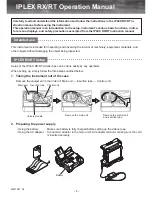
12
YDP-184 Owner’s Manual
Introduction
Panel Controls and Terminals
Control Panel
1
[
P
] (Standby/On) switch.................... page 15
For turning the power on or setting it to standby.
2
[MASTER VOLUME] slider ............... page 17
For adjusting the overall volume.
3
[
u
]/[
d
]/[<]/[>] buttons, display......... page 20
For selecting an item or setting a value using the
buttons corresponding to the display indication.
4
[FUNCTION] button .......................... page 77
Pressing this button alternates the displays among
“Voice” menu, “Song” menu, “Metronome/Rhythm”
menu, “Recording” menu and “System” menu, from
which you can make detailed settings for the related
functions.
5
[EXIT] button ..................................... page 20
Pressing this button exits from the current display, or
returns to the Voice or Song display.
6
[CFX GRAND] button........................ page 22
For selecting the “CFX Grand” Voice.
7
[STRINGS] button .............................. page 22
For selecting the “Strings” Voice.
8
[VOICE] button .................................. page 23
Calls up the Voice list display.
9
[DUAL/SPLIT] button ................. pages 29, 30
For playing two Voices simultaneously, or different
Voices on the left- and right-hand sections of the
keyboard.
)
[PIANO ROOM] button..................... page 24
Calls up the Piano Room display where you can
select an optimum piano sound and adjust the touch
response.
!
[SONG/DEMO] button ...................... page 36
Calls up Song List for selecting a demo Song or a
Song to playback or edit.
@
[REC] button....................................... page 49
For recording your keyboard performance.
#
[
R
/
K
](Play/Pause) button .................. page 38
For alternately playing back and pausing the Preset
Songs or your recorded material.
$
[METRONOME] button..................... page 33
For using the metronome functions.
%
[RHYTHM] button............................. page 48
For using the rhythm functions.
^
[TEMPO] button ................................ page 33
For setting the tempo.
A-1 B-1 C0
D0
E0
F0
G0
A0
B0
C1
D1
E1
F1
G1 A1
B1
5
7
)
6
8
3
9
9
#
!
@
@
^
$
%
%
1
2
4
Each key has a note name; for example, the
lowest (farthest left) key on the keyboard
corresponds to A-1, and the highest
(farthest right) key to C7.













































